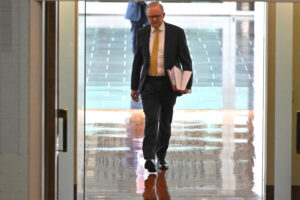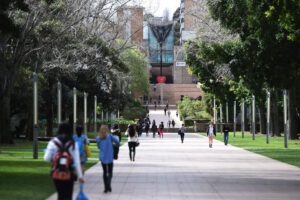It’s easy to avoid a hard question by simply saying the government “should” provide more money to the universities. But there’s a long list of things the Morrison government should do: extend the JobKeeper payment to casuals and temporary residents; permanently boost unemployment benefits; provide support to the arts and entertainment industry; introduce a carbon price. And avoiding hard questions, by focusing on what “should” happen, isn’t going to spare the academics in the vice-chancellors’ firing lines.
So, what can be done?
Well, right now, Australia’s best-known universities are sitting on billions of dollars’ worth of cash, bonds, shares and other financial assets.
According to their annual reports, the University of Sydney has financial assets of $2.1 billion, the University of Melbourne $3.1 billion, and the Australian National University $1.8 billion.
Much of these funds have been accumulated by charging students, both domestic and international, more for their courses than those courses cost to deliver. Charging “customers” far more for “products” than they cost to make is, of course, how all businesses make profit for their shareholders. But are students purely customers, and are our publicly owned universities really businesses?
The desire for our public universities to turn a profit needs reconsidering. As does the logic of vice-chancellors stockpiling decades of profits in their institution’s investment accounts.
Put simply, why are our universities collectively sitting on more than $20 billion in cash and shares? If they were saving our billions for a rainy day, it’s hard to believe they haven’t noticed that it’s already pouring.
Not only do our universities teach neoliberal economics, they now embody it.
Our higher education sector relies on competition between institutions and employees more than any other public service. Their staff are more casualised than those in any other public sector workforce.
The justification for paying some VCs three times what the prime minister earns is, quite explicitly, that they run such large “businesses”. But if universities are a business, they are not very transparent with their owners about their strategy, decision-making or priorities.
Despite nostalgic ideas of academic freedom and tenure, the brutal reality of the academic labour market is that about two-thirds of our academics are on insecure contracts – casual or fixed-term. Young academics are ruthlessly played off against each other in the race for the holy grail of a full-time academic job.
“Devil take the hindmost” notions of neoliberalism are used to justify the appalling conditions dangled in front of aspiring future professors, just as “winner take all” notions justify the $1 million-plus salaries paid to some vice-chancellors.
Meanwhile, as universities have obsessed over rankings and ratings, no public good has been more commodified than a university degree.
The enormous marketing departments of our universities ensure we know our higher education institutions rank among the best in the world, although there’s a distinct lack of billboards shouting that these same institutions are towards the bottom of the league tables when it comes to staff-student ratios.
This brings us to the “product” that universities sell. While there is no doubt Australia’s universities still offer a broad range of world-class degrees, the range of subject offerings has been deliberately narrowed as a result of decades of rhetorical and organisational change focused on making graduates “job ready”.
It’s understandable why a 17-year-old would be keen to know what job they will get at the end of their degree, but it’s less clear why the public at large should pay the upfront fees for the degree of an aspiring banker.
The determination of universities to spruik their ability to boost future incomes of their customers has come at the expense of the university sector’s ability to explain the broad contribution it makes to society. For decades, VCs have emphasised the private benefits to be had from a university – yet they are surprised when the public doesn’t want to give them more funding.
The clearest evidence that the Australian academy has a neoliberal soul – beyond the competition, casualisation and commodification that have redefined our universities – is the way they manage “their” money.
In 2018, Sydney University made a profit – called a “net result”, since universities are technically non-profit – of $171.1 million, Melbourne University $69 million, and Deakin University $51.5 million.
No public school or public hospital would brag about how they were stockpiling some of this year’s revenue to spend on future citizens, yet our universities pay bonuses to their leaders when they succeed in overcharging their current students and underpaying their current staff.
And already Australia’s vice-chancellors are not only the best-paid public servants in Australia, they are also among the best-paid academics in the world.
The justification for paying some VCs three times what the prime minister earns is, quite explicitly, that they run such large “businesses”. But if universities are a business, they are not very transparent with their owners about their strategy, decision-making or priorities.
Everyone knows Australian universities make a lot of money from foreign students, and everyone knows Covid-19 has diverted those rivers of gold from our shores for the time being. Yet nobody who read the annual report of one of Australia’s three-dozen public universities would be able to figure out just how much profit we make per student.
We have been told for years that the profits our universities make from foreign students cross-subsidise the cost of teaching Australian students. If that’s the case, why have the fees we charge domestic students grown steadily while foreign student enrolments have grown rapidly?
Now, as our universities have been cut off from international student revenue, thousands of academic jobs are at risk. But despite claiming to run a “business”, some of those well-paid VCs are asking their casual staff to volunteer to mark assignments. How’s that for neoliberal hypocrisy?
The biggest problem with the idea our universities are run like businesses, though, is the contradictory way the academy deals with the vices and virtues of debt.
Our universities spend a fortune telling every aspiring university student in Australia that borrowing $40,000 to $80,000 is the best thing they can do to set themselves up for life. “Invest now and reap the rewards later”, the baby boomers told everyone younger than them. But when it comes to the universities themselves, they do the opposite.
If universities have been overcharging their students for decades to save for a rainy day, then this is the day. Rather than sacking their staff, or cutting their pay, our higher education sector should spend some of the $20 billion it has put aside.
Not on new buildings, or marketing campaigns, but on saving its truly priceless asset – its staff.
If our universities value academia – and the role these institutions play in fostering critical thought, groundbreaking research and meaningful debate – they should ditch the casual contracts and protect their staff from the Covid-19 crisis, rather than toss them out into a labour market where their chances of re-employment are even lower than the faint prospect of a 30-year-old academic getting tenure.
And even if universities are only committed to the viability of their growth plans – and business models they have spent tens of millions of dollars paying consultants to prepare – then they should take 2020 on the chin and use their cash reserves, or take on some debt, to stay the course and ensure they come out of this crisis ready to take on the world.
The Morrison government’s decision to provide a funding boost, via the JobKeeper payments, to the four private universities in Australia, but not to our public universities, is as capricious as it is predictable.
There is no doubt the government should provide additional funding to our smaller and more financially vulnerable public universities, but there is also no doubt that, regardless of government policy, our universities should spend their enormous financial reserves before they lay off their pool of casual academics and risk creating a lost generation in our higher education sector.
Between the Lines Newsletter
The biggest stories and the best analysis from the team at the Australia Institute, delivered to your inbox every fortnight.
You might also like
EXPLAINER: What are personal staff, and why do they have Clive Palmer contemplating another political campaign?
Clive Palmer, the billionaire coal miner who funded the Palmer United Party, United Australia Party and Trumpet of Patriots, is considering another political run.
Uni Canberra is spending big on things not needed, while cutting staff to save money
Australia’s beleaguered university sector is never far from the headlines these days. Former Labor leader and current University of Canberra Vice-Chancellor Bill Shorten probably doesn’t envy his former ministerial colleagues who are currently on the campaign trail, but nonetheless, he’s in the news today. The Canberra Times reports that Shorten is announcing a new voluntary
At Australian unis, do you get what you pay for?
35 years after the HECS/HELP system began, university students now pay much more for much less.


